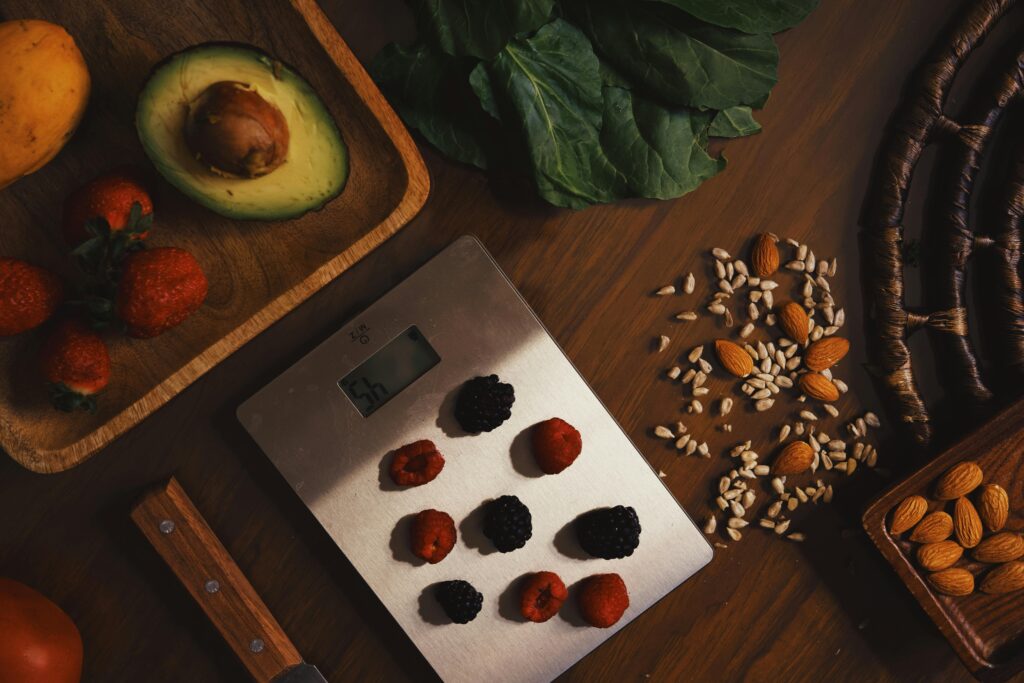
If you’ve ever tried to lose weight, build muscle, or just eat a little healthier, you’ve probably heard the word “macros” thrown around. It sounds like something out of a science class, but don’t worry—calculating your macros is way simpler than it seems.
Stick around, and I’ll explain macros, why they matter, and how to calculate them in a way that actually fits your goals.
What Are Macros?
“Macros” is short for macronutrients, the 3 main nutrients your body needs to function: protein, carbohydrates, and fat.
You can read about macros and how they work in more detail in another post I wrote, but here’s a quick breakdown:
- Protein builds and repairs muscle and helps keep you feeling full
- Carbs give you energy—your brain and body run on them
- Fat supports hormones, brain health, and helps absorb fat-soluble vitamins
Each macro has a calorie value:
- Protein = 4 calories per gram
- Carbs = 4 calories per gram
- Fat = 9 calories per gram
So, when someone says they’re “counting macros,” they’re just tracking how many grams of each macronutrient they eat every day. Ultimately, tracking macros allows people to balance their calorie intake and ensure they’re getting adequate amounts of each nutrient split up over their daily calories.
Why Should You Care About Calculating Your Macros?
Tracking macros isn’t just for bodybuilders or fitness influencers. It’s for anyone who wants to eat with more intention. Whether your goal is weight loss, muscle gain, or just staying healthy, understanding your macros helps you:
- Eat the right balance of nutrients
- Stop guessing how much you should eat
- Make progress without starving or overdoing it
Calculating Your Macros
Let’s break this down into easy steps.
Figure Out Your Calorie Needs
First, you need to know how many calories your body uses daily. How much energy (calories) you use every day is called your total daily energy expenditure (TDEE). It includes the calories you burn at rest plus the ones you use for movement, workouts, etc.
You can use an online TDEE calculator to estimate your TDEE using your age, weight, height, and activity level. This won’t be 100% accurate, but it gives you a good starting point.
Let’s say your TDEE is 2,000 calories per day. This is the number you’ll base your macros on. If your goal is weight loss, subtract 250–500 calories. If you want to gain muscle, add 250–500 calories. If you’re maintaining, keep it as is.
Pick a Macro Split
Picking a “macro split” depends on your goals. Here are a couple of common options:
- Balanced and muscle gain: 40% carbs / 30% protein / 30% fat
- Fat loss: 35% carbs / 35% protein / 30% fats
You don’t have to obsess over hitting these exact numbers—just pick a ratio that supports your goals. You may find a different split that makes you feel and perform your best. For example, some people thrive on a low-carb (keto) diet, while others don’t.
Turn Percentages Into Grams
Let’s stick with the example of 2,000 calories and a 40/30/30 split:
- Carbs: 40% of 2,000 = 800 calories → divide by 4 = 200g carbs
- Protein: 30% of 2,000 = 600 calories → divide by 4 = 150g protein
- Fat: 30% of 2,000 = 600 calories → divide by 9 = 67g fat
Your target is 200g carbs, 150g protein, and 67g fat per day.

How to Track Your Macros Without Losing Your Mind
Once you know your numbers, it’s time to start tracking. The easiest way is to use an app.
Here are some popular ones:
- MyFitnessPal is a common option, and the free version works fine
- Cronometer is amazing for its nutrient breakdowns—I use this one when I’m tracking
- MacroFactor or Carbon Diet Coach are paid and more advanced apps
Make Tracking Easier
Your health and fitness—including tracking—should simplify your life, not complicate it. Here are a few tips to help get you going:
- Use a food scale because estimating often leads to under- or overeating.
- Scan barcodes with your app for accuracy.
- Pre-log your meals if you’re planning ahead.
- Start with one meal a day if tracking everything feels overwhelming.
- Batch-cook foods so you don’t always have to measure every ingredient.
- Be flexible—perfection isn’t the goal, consistency is.
- Recalculate every few months as your weight, activity, or goals change.
Will you hit your targets perfectly every day? Probably not. And that’s okay. What matters most is being consistent and learning as you go.
Watch Out for These Common Mistakes
Even if your math is spot-on, a few missteps can throw you off:
- Eyeballing portions: You’ll be shocked how small a tablespoon of peanut butter actually is.
- Ignoring small snacks: That handful of chips? Those bites while cooking? They add up.
- Not adjusting: If your weight or energy levels plateau, it might be time to tweak your calorie intake or macro split.
Remember, this is a tool, not a prison. Your food diary isn’t being graded.
Calculating & Tracking Your Macros Doesn’t Have to Be Complicated
Calculating your macros might sound like something only hardcore fitness folks do, but it’s actually a great way to eat with purpose, without cutting out the foods you love.
Here’s the quick recap:
- Figure out your daily calorie needs
- Choose a macro split based on your goal
- Convert those percentages into grams
- Track your food and stay consistent
It takes a little effort upfront, but it gets easier. And the best part? You’re not blindly guessing anymore—you’re actually in control. Contact me today for a free consultation if you’d like some 1:1 coaching to help you get on the right track!